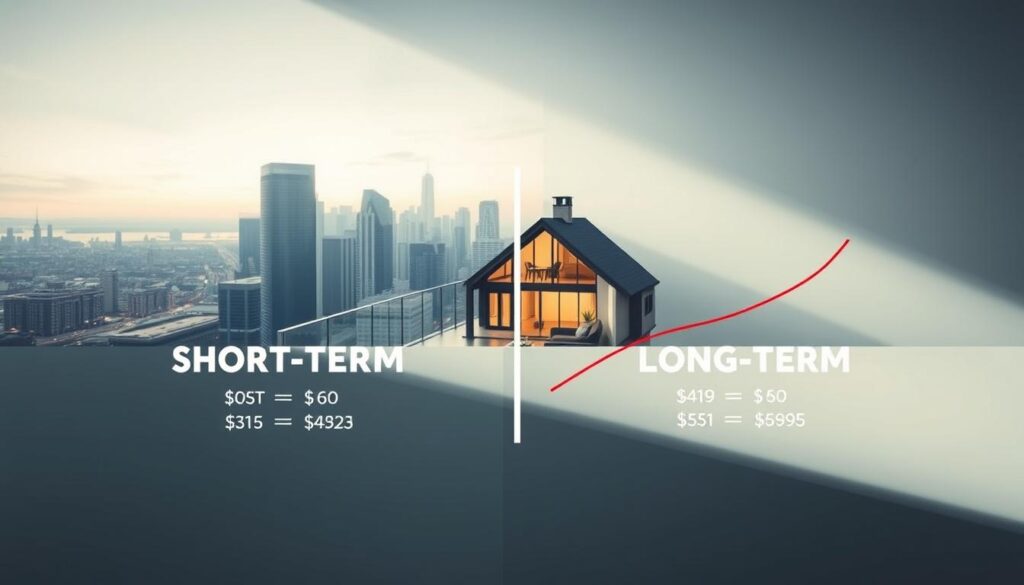Deciding whether to buy a home or keep renting feels sharper in 2025. National data show average monthly mortgage payments are about $2,768, while typical rent runs near $2,000 after inflation and renters insurance — roughly 38% lower for renters today.
This guide uses updated calculators and real cost data to compare choices over the long run. We’ll weigh upfront fees, ongoing payment obligations, maintenance, taxes, and the opportunity cost of cash you might invest instead of tying it up in a house.
What matters most is how many years you plan to stay and how much you value equity versus flexibility. Interest rates, local market conditions, and home-price growth can widen or shrink the gap between buying and renting.
Key Takeaways
- Monthly mortgage outlays are higher than rent on average today, but ownership can build equity over time.
- Updated calculators factor in taxes, selling proceeds, and opportunity costs for apples-to-apples comparisons.
- Your expected years in a home and desire for flexibility are key to the right decision.
- Upfront costs and ongoing maintenance shift money from liquidity into estate value.
- Local market and interest-rate shifts often determine whether buying pays off in the long run.
2025 snapshot: the housing market favors renters in the short term
Across the country, 2025 looks like a renter’s market for immediate housing costs. On average, the typical monthly mortgage payment runs about $2,768, while rent clocks near $2,000 — roughly 38% higher for buyers per month.
The gap widened year over year in most large metros as interest rates and home prices rose. At the same time, a surge in apartment deliveries eased rent pressure and expanded choices for renters.
What the monthly mortgage figure covers: principal, interest, property taxes and homeowners insurance. It excludes maintenance, closing fees and many ownership incidentals, so the comparison focuses on core housing expenses.
- Higher rates and constrained for-sale inventory pushed buyer costs up.
- More rental supply gave renters negotiating power and steadier rents.
- These are national averages — local home prices and market conditions can flip the math.
Bottom line: whether rent is cheaper today depends on where you live and how long you plan to stay. This snapshot sets up a deeper look at ownership cost components and the breakeven timing in the next section.
Mortgage vs Renting: short-term costs, long-run gains, and the breakeven point
Comparing initial deposits and monthly bills shows why buying can feel costly now even if it gains over time.

Upfront contrasts: buyers must fund a down payment plus closing costs (often estimated near 6% for selling-side changes), while renters typically pay a security deposit and modest application or broker fees. That initial gap is the first major cost to weigh.
Monthly obligations and upkeep
Owners face mortgage payments, property taxes, and homeowners’ insurance. Utilities often run about $100 higher per month for owners. Budget 1–2% of home value annually for maintenance and repairs (1.5% is a common default).
Taxes, equity, and opportunity cost
Mortgage interest and property taxes may help if you itemize, but many get little extra benefit versus the standard deduction. Over the years, principal paydown raises home equity—an ownership advantage. Still, the cash tied to a down payment could have been invested, so credible calculators discount both paths and include opportunity cost.
- Breakeven: the year cumulative buying costs fall below renting after factoring in equity, appreciation, taxes, and selling costs.
- Small changes to rates, appreciation, or time horizon can move the breakeven year significantly; model multiple scenarios.
Your location matters: renting vs buying across U.S. metros
City-level differences in home prices, taxes and insurance mean the rent-versus-buy equation looks very different across metros. Local supply, wage growth and financing together drive whether a mortgage payment per month will beat rent over time.
Coastal tech hubs with the widest gaps
San Francisco, San Jose, Seattle
In san francisco the typical mortgage runs about $8,882 while rent is near $3,055 — a 190.7% gap. San Jose posts similar extremes, and Seattle shows a 119.5% split. These markets have high home prices and strong demand, so buyers face much larger monthly costs than renters.
![]()
Detroit, Philadelphia, Cleveland and the Rust Belt
Rust Belt metros show minimal differences. Detroit’s mortgage and rent are nearly even, and Cleveland and Philadelphia also have much smaller gaps. In these places, buyers can reach breakeven sooner if they plan to stay.
National context and inventory
Nationally, an average mortgage payment is $2,768 versus about $2,000 rent in 2025 — roughly a 38% gap. More rental deliveries this year expanded options for renters, while homes for sale stayed limited. Property taxes, insurance and local fees further tilt the math by metro.
- High-gap markets often need a long tenure to justify buying.
- Smaller gaps make ownership more attractive sooner for buyers.
Lifestyle and flexibility: beyond the dollars
Dollars matter, but daily life and plans matter too. Flexibility often decides whether a person should rent or buy.
Mobility and lease flexibility
Renters can move at the end of a lease with far less friction, which helps with job changes or family moves. That mobility saves time and reduces the hassle of selling a house.
Renters also avoid direct responsibility for most repairs and major maintenance. Property management usually handles service calls, so renters spend less money and time on upkeep.
Staying power and equity
People who plan to stay several years gain from paying down principal and building equity when owning a home. The longer the hold, the more equity compounds and the more likely selling covers transaction costs.
Owning a home brings borrowing power against that equity, but it also adds ongoing items like property tax, insurance and upkeep.
Predictability and responsibilities
A fixed-rate mortgage keeps the principal-and-interest portion of your monthly payment stable, offering budget predictability not available to many renters.
However, homeowners must budget for variable costs: taxes, insurance, and maintenance. Those line items can spike and require emergency reserves.
Choosing by lifestyle
Some people value customizing and renovating their house. Others prefer a turnkey apartment and fewer obligations.
Think about how often you expect to move, career flexibility, family needs, and how much you value stability versus day-to-day ease. Align your expected time horizon with those priorities before picking the option with the lowest monthly cost.
How to compare for your situation: calculators, inputs, and assumptions
Use a reliable calculator to see how your unique numbers change the outcome over five, ten, and twenty years. A model that reflects your cash, timeline and tax situation gives the clearest picture of costs and benefits.
Key inputs to enter
Start with monthly rent, target home price and planned down payment. For first-time buyers, a 9% down-payment baseline is realistic and helps estimate PMI when under 20% equity.
Loan and recurring owner details
Choose a fixed-rate term and expected interest rates. Include PMI if down payment is below 20% and model its removal once you reach 20% equity.
List recurring costs: property taxes, homeowners insurance, HOA dues and an extra utilities delta (NerdWallet suggests about $100/month). Budget 1–2% of home value for maintenance annually.
Methodology and personalization
Good tools compound inflation, model rent growth and home-price appreciation, and subtract selling costs (about 6%). Add capital gains rules for a primary residence and account for opportunity cost on cash you might invest instead.
- Enter income, filing status and marginal tax rate so tax benefits are counted only if you itemize.
- Compare cumulative month-by-month cash flows to find your breakeven year.
| Input | Default | Why it matters |
|---|---|---|
| Down payment | 9% | Determines PMI and initial equity |
| Maintenance | 1.5%/yr | Captures ongoing repair costs |
| Utilities delta | $100/mo | Reflects larger home operating costs |
| Selling costs | 6% | Affects net proceeds and breakeven |
Making the call in 2025: expert guidance for buyers and renters
Make this choice by matching your timeline to realistic cost models, not by chasing low rates or market hype. Experts advise patience and clear planning so your decision holds up over the years.
“Date the rate, marry the house”: don’t rush the decision
“Date the rate, marry the house.”
Take your time. Choose a home that fits your life. If rates fall later, buyers can refinance to improve payment and overall affordability.
Plan to stay at least five years to overcome transaction costs
Economists suggest planning to stay home for at least five years. High fees for buying and selling make short holds risky.
Short-term affordability vs long-run equity and wealth building
- Be realistic: renting often wins on monthly cash in 2025, freeing up money now.
- Think long run: buying converts part of each mortgage payment into home equity over years.
- Use tools: test multiple scenarios and conservative assumptions before deciding whether rent today outweighs future gains.
Conclusion
Your best move depends on time in market, cash on hand and whether you want control or flexibility.
In 2025 the typical mortgage payment outpaces average rent, but that gap changes by city as home prices, property taxes and insurance vary.
Use a trusted calculator that includes maintenance, taxes, insurance, appreciation and the opportunity cost of cash to find a breakeven year for your situation.
If you stay several years and tolerate ownership duties, equity and estate value can reward you. If you keep renting, invest the savings regularly to capture long-term gains.
Gather your monthly rent, target price, down payment and tax details, then run a rent buy comparison tailored to your metro to decide with confidence this year.
FAQ
In 2025, is it generally cheaper to buy a home or keep renting?
Short-term, renting often costs less in many U.S. metros because interest rates and home prices keep monthly carrying costs high. Over a longer horizon — typically five to seven years or more — buying can become cheaper once you build equity, benefit from principal paydown, and capture any home price appreciation. Your local market and how long you plan to stay are decisive.
What upfront costs should I expect when buying compared with renting?
Buyers usually need a down payment (median for first-time buyers around 9% in recent years) plus closing costs, inspections, and moving expenses. Renters face a security deposit, first and last month’s rent in some markets, and possible broker fees. Lenders also require reserves and private mortgage insurance if your down payment is under 20%.
How do recurring monthly costs differ between owning and renting?
Owners pay mortgage principal and interest, property taxes, homeowners insurance, and often HOA dues. Renters pay monthly rent and may buy renters insurance. Owners should also budget for maintenance and utilities; renters sometimes have some utilities included. Compare total monthly outflow, not just the payment labeled “mortgage” or “rent.”
How much should homeowners budget for maintenance and repairs?
A common rule is 1–2% of the home’s value per year for maintenance and repairs. For a 0,000 house, that’s ,000–,000 annually. Newer homes can cost less; older homes and those with large yards or complex systems often cost more.
Do tax deductions make buying more attractive?
Mortgage interest and property taxes can reduce taxable income, which helps some buyers, especially early in the loan when interest is higher. But the standard deduction is larger now, so only many who itemize or have sizeable interest and state taxes will see big tax benefits. Consult a CPA for your marginal tax impact.
How does home equity build over time?
Home equity grows as you pay down principal and if the property appreciates. Early years of a 30-year fixed loan are interest-heavy, so equity builds slowly at first. Over time, more of each payment reduces principal, accelerating equity accumulation, which you can tap via sale or a home equity line of credit.
What is the opportunity cost of using cash for a down payment?
Cash used for a down payment could instead be invested in stocks, bonds, or retirement accounts. If those investments outperform home appreciation minus costs, renting and investing may win financially. Compare expected investment returns, your risk tolerance, and how much you value housing stability.
How do inflation and rent growth affect the buy-or-rent decision?
Inflation tends to raise replacement costs and rents. If rents climb faster than mortgage payments (fixed-rate), owning can offer a hedge because your principal and interest stay level while rents rise. But local rent trends and home price appreciation vary, so use local data for forecasts.
What is the breakeven point for buying versus renting?
The breakeven point is when cumulative costs of buying (including transaction and holding costs) equal cumulative renting costs plus any investment returns. For many buyers in 2025, this is often five to ten years, depending on home price growth, rent inflation, transaction fees, and interest rates. Run a personalized breakeven analysis or use an online calculator.
How does location change the analysis?
Coastal tech hubs like San Francisco, San Jose, and Seattle still show large gaps where buying is costly relative to renting. Rust Belt cities such as Detroit, Philadelphia, and Cleveland often have smaller gaps and faster breakeven timelines. Always compare local rent-to-price ratios, inventory, and job prospects.
What should I consider about inventory and rental supply in 2025?
Increasing deliveries of new rental units can ease rent pressure in some metros, while limited homes for sale keeps buyer competition high. Low for-sale inventory raises prices and can lengthen the breakeven horizon for buyers in tight markets.
How does lifestyle and flexibility factor into the decision?
Renting offers mobility, shorter commitments, and less responsibility for repairs. Owning offers stability, customization freedom, and the potential to build wealth. If you expect job moves or lifestyle changes in the next few years, renting may suit you better despite potential long-term financial upside from buying.
What inputs should I use when running a buy-versus-rent calculator?
Key inputs include monthly rent, target home price, down payment amount, loan rate and term, property taxes, homeowners insurance, HOA fees, expected maintenance costs, rent growth rate, home appreciation rate, and your marginal tax rate. Use conservative and optimistic scenarios to test sensitivity.
What mortgage details matter for first-time buyers?
Fixed-rate loans provide payment predictability, while adjustable-rate loans can offer lower initial rates with future risk. Private mortgage insurance typically applies when down payment is under 20% and can be removed once you hit 20% equity. Shop rates from Freddie Mac, Fannie Mae-approved lenders, and compare closing costs.
How should I personalize the decision based on my taxes and time horizon?
Your filing status and marginal tax rate affect the value of interest and property tax deductions. A longer time horizon favors buying because transaction costs amortize over many years. If you expect to stay five years or more and can handle upfront costs, buying often becomes more attractive.
What rule of thumb do experts use when advising buyers in 2025?
Many real estate advisors suggest planning to stay at least five years to overcome transaction costs and capture potential appreciation. Another common phrase: “date the rate, marry the house”—focus on the property fit and be ready to refinance if rates fall.
If I expect to move within three years, should I buy?
Short-term ownership often fails to cover transaction costs and market volatility. If your timeline is under five years, renting usually makes more financial sense unless you have a very low purchase price, significant expected appreciation, or a plan to rent the property out later.

